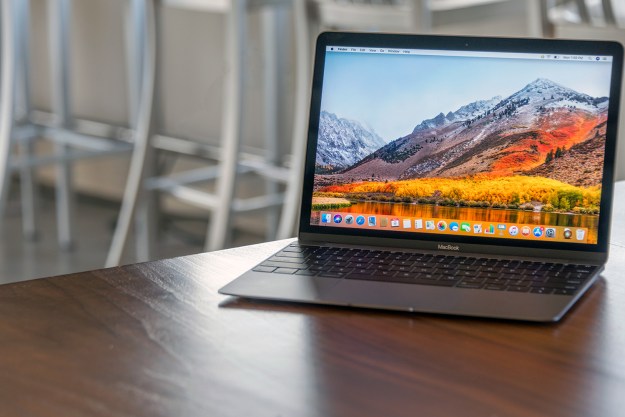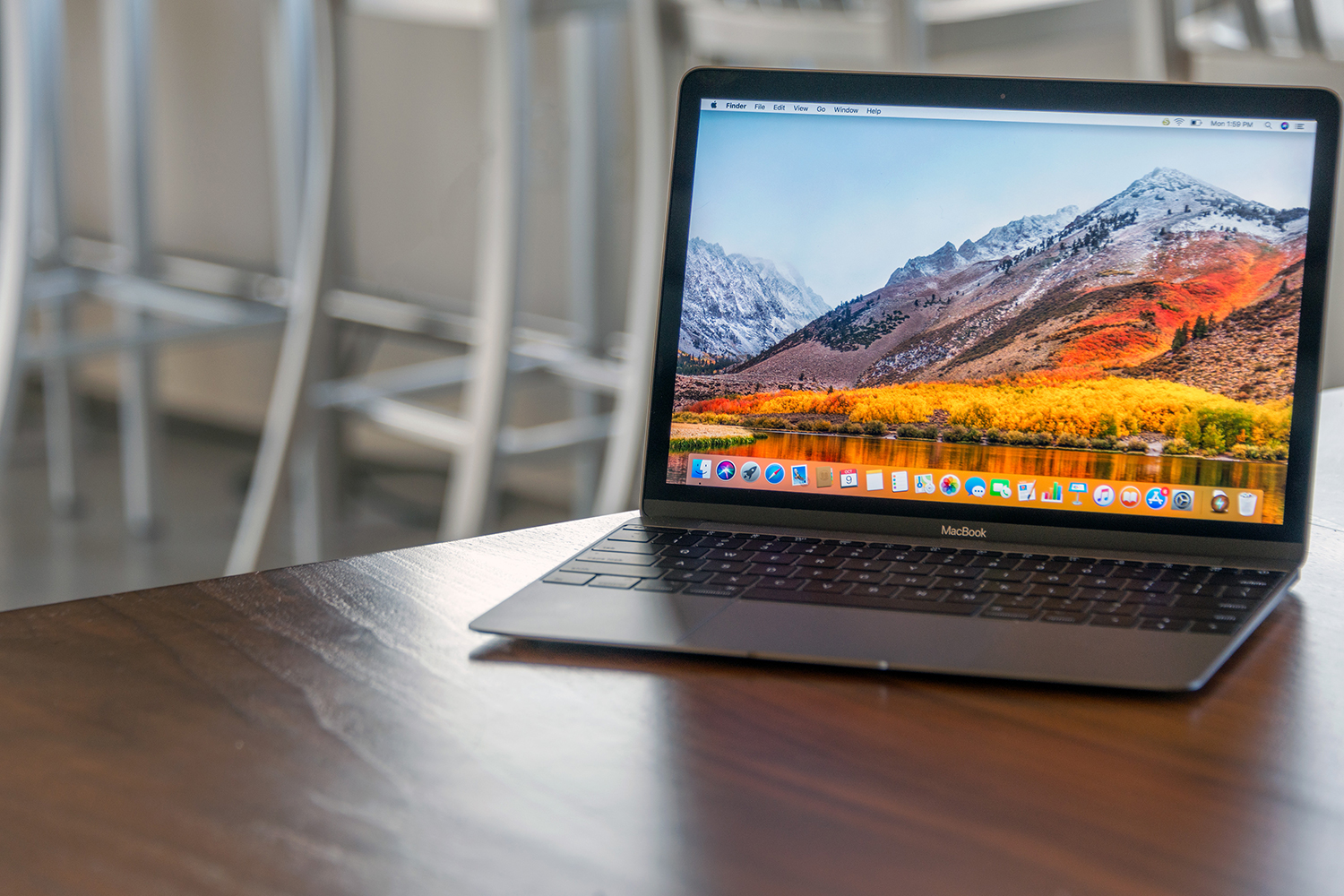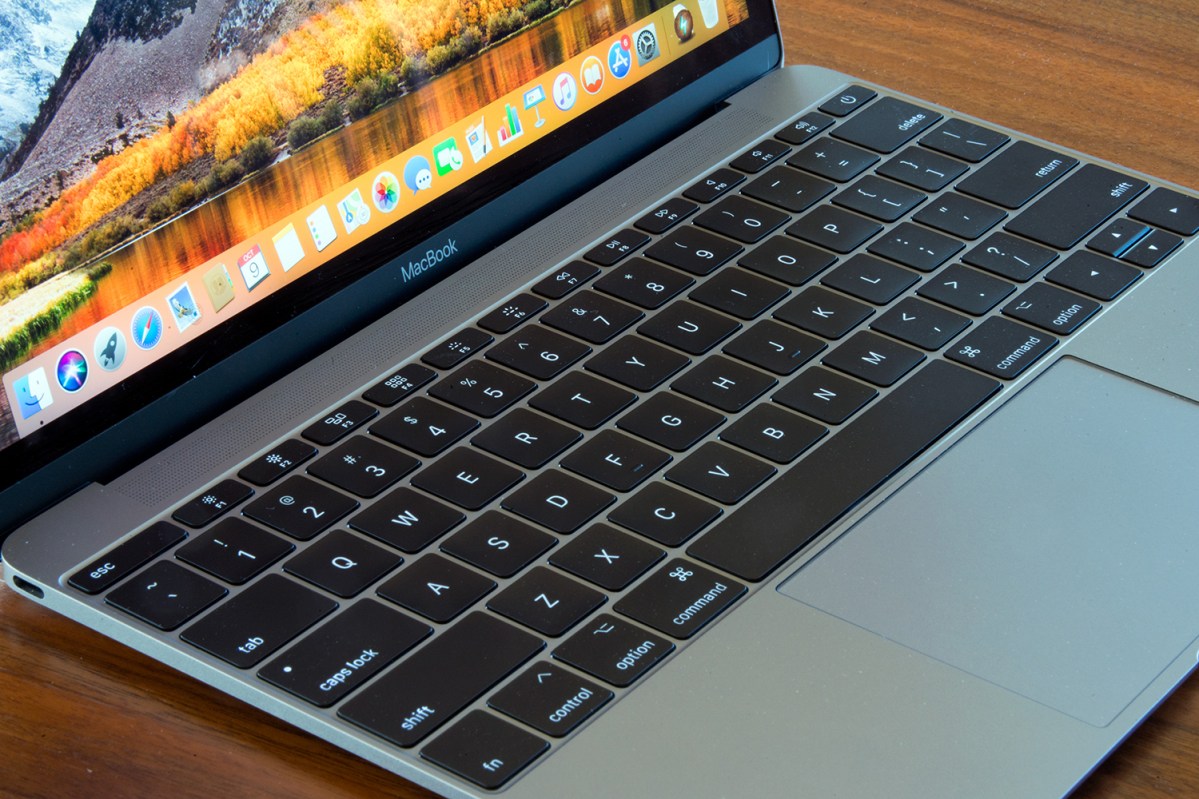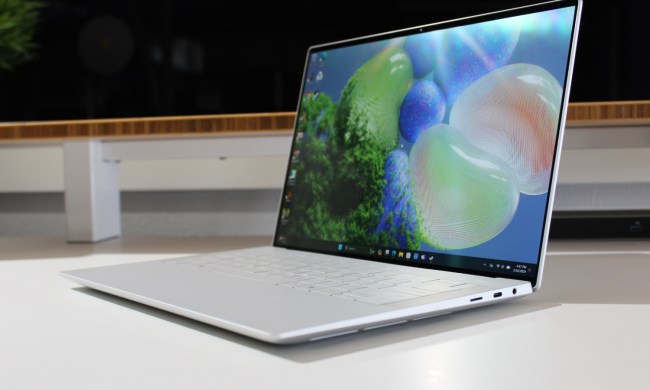
“The MacBook outshines and outlasts the competition.”
- Unparalleled craftsmanship
- Solid battery life
- Excellent display
- Surprisingly robust speakers
- One USB-C port just doesn’t cut it
- Not at all competitively priced
Editor’s note: Apple has discontinued the 12-inch MacBook. It’s replaced by the newer, more affordable MacBook Air. We think the Air is a better choice for most people, even when the MacBook 12-inch is available for a discount. The Air has a larger display and better performance.
It’s been a tough couple of years for the entry-level MacBook. The multi-colored, polycarbonate MacBook was once the popular choice for years, before it was replaced by the thin, unibody MacBook Air back in 2011.
In 2015, the MacBook was brought back with a controversial redesign — and sales took a hit. In early 2016, Mac sales saw its first year-over-year decline in 15 years.
The new MacBook was a looker, but its high price and low performance pushed customers toward more cost-effective competitors, including the MacBook Air that just received an upgrade (in both components and pricing) in October 2018. The 2017 MacBook model was intended to change all that. Featuring a 7th-gen Intel Core m3 processor, 8GB of RAM, and 256GB of storage space, the new 12-inch MacBook ramped up performance across the board and aimed to give customers more bang for their buck.
Meticulous craftsmanship
The 12-inch MacBook is an impeccably crafted laptop. Every inch is engineered to perfection, from the laser-cut speaker grill to the silky glass trackpad and the high-gloss sheen applied to the iconic Apple logo on the lid. There’s no doubt that this is a luxury device from the moment you first touch it, and it’s an absolute joy to use.

There are some clever design flourishes that help set the MacBook apart from similar competitors. When it’s closed and set on a flat surface, it looks impossibly thin — the angled edges give the appearance that it’s much thinner than it is. Upon the release of its redesign, the MacBook was the absolute thinnest of its kind at 0.52 inches, though it’s been bested this year by a number of laptops. In particular, the HP Spectre 13 comes in at 0.41 inches and the 2018 Acer Swift 7 is the thinnest of all at a stunning 0.35 inches. The 2018 MacBook Air is only slightly thicker at 0.61 inches, although it’s considerably heavier by three-quarters of a pound because of its larger 13.3-inch display.
Opening it up, the keyboard stretches to either edge of the chassis, with the speaker running the full length of the top-edge. It’s an elegant, economical design that uses all the available space to maximum effect.
Every inch is engineered to perfection, from the laser-cut speaker grille, to the silky glass trackpad.
You can see the DNA of previous MacBooks here in the bezels around the display and in the proportions of the chassis. It’s clearly a descendent of the popular $1,000 MacBooks of yore, but there’s a refinement here — a uniquely modern feel. It’s plain but never boring. Speaking of those bezels, they’ve been reduced but don’t quite compare to laptops like the Dell XPS 13 or the HP Spectre 13.
Huawei’s MateBook X is perhaps the MacBook’s most obvious competitors, as it rather directly apes Apple’s design. We like the MateBook X, but its design isn’t quite up to Apple’s standard. Though also rather efficient in its use of space, the Huawei option doesn’t feel as solid when handled, or when the display is opened.
Other laptops, like the Dell XPS 13, go a different direction entirely, using soft-touch materials to make the system feel warmer and more approachable. We like that approach, but if you want a cool, slick, thin device that feels like it was chiseled from one piece of metal, it’s hard to beat the MacBook.
On the MacBook’s larger sibling, the MacBook Pro 13, each side of the chassis features a single USB-C port (or two, if you go for the Touch Bar model). It’s simple, elegant, and just enough for everyday use. You can charge your phone while your laptop is plugged in, or use an external mouse. You can even choose which side your power adapter plugs into, which is much more convenient than it sounds.
By contrast, the 12-inch MacBook has a single USB-C port one the left side, and a single headphone jack on the right. At first glance, it seems like a daring move, an effort to pare away the non-essential elements. In use, it’s a step backward, plain and simple. You’ll butt up against this limitation in your everyday life, probably more than once during a single day.
The MacBook has only one port. It’s an unnecessary hindrance, not a feature.
You can’t plug in an external mouse and keyboard (without a dock). You can’t charge while you load photos off a flash drive. You can’t choose which side to plug your power cord into. Investing in the 12-inch MacBook means investing in a USB-C hub, which also means its ultra-lightweight build is compromised by the need to carry around a bulky adapter if you ever need to, say, plug in your phone while your laptop charges. Prepare to live that #donglelife.
Some of the Windows-based competitors do follow in Apple’s footsteps, but most have at least one additional port. The Dell XPS 13 has a mix of Thunderbolt 3 and USB-C, and Microsoft’s Surface Laptop (and Laptop 2) has a USB 3.0 port combined with DisplayPort (but no Thunderbolt 3). The HP Spectre 13 offers three USB-C ports, which solves some of the I/O problems in a frame that’s even thinner than the MacBook. Even the cheaper, new MacBook Air has one more Thunderbolt 3 port.
Just for reference, how many ports did the 2011 MacBook Air have? Five — two USB ports, a Thunderbolt 2 port, an SD card reader, and a MagSafe power port.
Taptic feedback
The new MacBook keyboard could be a polarizing issue for keyboard purists. It features the same second-generation butterfly switches introduced in the 2016 MacBook Pro lineup, with its characteristically short key travel and snappy response. It can feel like keystrokes end a bit suddenly at first, but once you get used to it, the keyboard is enjoyable, even if it’s not the best.
The keys themselves feel large and spacious, which is an achievement considering the size of this laptop. Every keystroke ends in a sharp, satisfying click, which can be unpleasantly loud of you’re a quick typist. It’s also worth mentioning that the keyboard itself doesn’t flex at all, not even a bit. When you’re typing, the MacBook rests firmly on your lap or a table, and the keyboard is perfectly rigid no matter how hard you type.
Compared to the keyboard on a laptop like the Dell XPS 13, there’s a clear difference in the feel of each keystroke. On the XPS, you can expect a pleasant typing experience, as it feels like most other high-quality laptop keyboards these days. The MacBook’s keyboard feels very different. It’s louder, more tactile, and a bit too stiff.
Just below the keyboard is the touchpad. Even on such a small laptop, Apple somehow managed to make it feel spacious without ever feeling too big or too small. The Taptic Engine simulates actual mechanical clicks so well, we had to double-check that the 12-inch MacBook didn’t have a mechanical touchpad.
Multi-touch support continues to be among the best in class. The silky-smooth all-glass touchpad responds immediately to swipes of all kinds, offering a seamless multi-touch experience.
Feast your eyes
The display is another high point for the MacBook, an arena in which Apple has few real competitors. The glossy Retina display features 226 pixels per inch, and a max resolution of 2,304 x 1,440. That degree of pixel density is impressive on a display this small. Text is crisp and inky, and images possess a remarkable sense of depth — but finding wallpapers of sufficient resolution can be a bit of a chore.
In our tests, the MacBook’s display achieved top marks in nearly every category, coming in second only to the MacBook Pro 13. Its very good contrast ratio of 915:1 that’s shy of the MacBook Pro 13’s contrast ratio of 1200:1, while the 4K Dell XPS 13 and Huawei MateBook X fell into a typical range for most laptops, coming in at 850:1 and 690:1, respectively.
The displays on all four laptops are crisp, clear, and rich, but the MacBooks are just a cut above the rest, offering the kind of crystal-clarity you just don’t find very often elsewhere.

The MacBook also hit 91 percent of the finicky AdobeRGB color space, while the MacBook Pro 13 achieved a rare perfect score. On color accuracy, the MacBook hit 0.96, to the MacBook Pro’s 0.72. In that test lower is better, and these scores mean either one would be an excellent choice for creative professionals who need pitch-perfect color reproduction. The Huawei MateBook x and Dell XPS 13 don’t come close to achieving a score below one.
Taken together, these results add up to a very simple verdict – the MacBook’s display is a stunner. The only vaguely similar system that can be said to beat it the Samsung Galaxy Book 12, which has an OLED display. Yet that system, which is a 2-in-1, has plenty of other flaws and isn’t competing in quite the same arena.
The speakers on the MacBook are a pleasant surprise. Usually laptops of this size skimp on sound, but that’s not the case here. The single speaker grille running along the top-edge of the keyboard produces bright, resonant sound, with remarkable clarity — no matter how high or low the volume. Speaking of volume, the MacBook’s humble little speakers are more than capable of filling a room with sound.
Quick, and quicker
The MacBook features a 7th-gen Intel Core m3 processor, which doesn’t exactly inspire confidence. Even the new MacBook Air has an 8th-generation version of the Intel’s low-power CPU. As an efficient mobile processor optimized for battery life over raw performance, the Core m3 lacks the punch and horsepower of Intel’s Core i5 and Core i7 processors, but during everyday use it’s a surprisingly strong performer.
Even when we tried to stress the MacBook with daily tasks, it rose to the challenge. Opening several browser tabs all at once, working with Microsoft Word and Excel running multiple documents at once, the scrappy little m3 kept up beautifully.
Fire up some 4K video while Spotify is running, with a couple Word documents open, and you can start to see the upper limits of its capabilities, especially on battery power. When this happens, you might see some input lag until you close a few windows.
Looking at Geekbench scores, you can see how the Intel Core m3 stacks up to beefier processors like Core i5s and i7s. The Dell XPS 13 maintains a sizable lead in single core and multi-core performance here, thanks to its 7th-generation Core i7 processor. It’s a robust dual-core with Hyper-Threading, so it runs circles around the Core i5 and M3.
The XPS 13 takes that lead further in our Handbrake test, a standard 4K video encode. The Dell XPS 13 finished the encode in just 13 minutes, while the MacBook and even the 13-inch MacBook Pro finished it in 28 and 25 minutes respectively.
That’s an important note because the XPS 13, outfitted with an Intel Core i7, is the same price as the 12-inch MacBook. That’s a substantial performance gap for two laptops of the same exact price. Clearly, your money will buy better performance elsewhere.
It should be noted that Apple offers a Core i5 configuration of the MacBook, though it’s not the Core i5-7200U you’ll find in most Windows laptops. Instead, it’s a rebranded version (thanks Intel) of the Core m5 that’s now being referred to as a Core i5. So while that model will no doubt be faster than the Core m3, it’s not going to compete with a true Core i5 experience.
Speedy storage
Moving on to storage, the 12-inch MacBook is very quick on its feet, capable of throwing big files around without breaking a sweat. The 256GB SSD also partitions quickly, making it easier than ever to install a full version Windows with Boot Camp.
Looking at raw speed, the MacBook’s read speed topped out at 1355 megabytes-per-second, with a write speed of 1035MB/s. These are impressive figures, just ahead of what we’d expect from a laptop in this price range. For reference, the Dell XPS 13 hit a read speed of 469MB/s, and a write speed of 405MB/s (when last tested, with a SATA hard drive). At the other end of the spectrum, the MacBook Pro 13 achieved an impressive write speed of 1,348MB/s, and a read speed of 2,000MB/s right in the same neighborhood as what we got out of its larger sibling, the MacBook Pro 15.
The MacBook Pro 13 more than doubles the MacBook’s hard drive speeds. However, the entry level 13-inch MacBook Pro is the same price as the MacBook. Again, your money goes so much further elsewhere, even at Apple. Are you seeing a pattern here?
No fun and games
It’s no surprise that the entry-level MacBook is utterly incapable of running even the least demanding games. Its Intel Core M3 processor can get you through a workday, but its onboard graphics will never get you through a round of Battlefield 1.
Even when running 3DMark in Windows, the MacBook just can’t keep up with its competitors. The Huawei Matebook X and Dell XPS 13 both easily eclipse the MacBook’s graphical performance. Even in a relatively lightweight game like Civilization VI, the MacBook was only able to manage about 8 FPS on 1080p at medium settings (again, testing in Windows).
You might be able to run Hearthstone, but even then you’ll experience some significant slowdown when the effects kick in. The MacBook just isn’t made to game.
Portability
While Apple’s decision to use the Intel Core M3 chip might sacrifice some performance, it’s great at keeping power draw low even under heavy workloads.
Moving on to benchmarks, the MacBook managed to play our video loop test for a little over 8 hours. That’s more than you’d get out of most laptops, though just shy of what we got out of the MacBook Pro 13, which managed to survive for 10 hours on the same test. The Dell XPS 13 fell between the two, managing 9 hours.
On the more demanding Peacekeeper test, the 12-inch MacBook survived for just over four hours, while the MacBook Pro 13 and Dell XPS 13 were neck and neck at around five hours.
During everyday use on the MacBook we could get about six to seven hours of battery life before hitting the last 15 percent. That’s solid for such a small laptop, and it will see you through most of a workday. Having said that, the MacBook doesn’t appear to have an advantage over similar Windows machines. Laptops like the Lenovo Yoga 920 and HP Spectre 13 easily best them, while the powerhouse Surface Book 2 delivers three times the battery life.
Our Take
The MacBook is an exceptionally well-made device, and if you bought one you probably wouldn’t be disappointed. It will do everything you expect it to do — if you don’t try to play games — but it has one flaw. The price. It’s not just a problem because it’s expensive. Apple products are always more expensive than their competitors, as it’s a premium brand. There’s more to it.
Is there a better alternative?
And here it is. The biggest hurdle the MacBook faces. There are better alternatives everywhere.
The MacBook Pro 13 now starts at $1,300 (sans Touch Bar), and it’s superior in nearly every way. You miss out on a little hard drive space, but what you gain in processor speed, battery life, display quality, and ports more than makes up for the smaller hard drive.
If you’re just looking for a compact laptop, you have even more options. The Dell XPS 13 and Huawei MateBook X Pro are great examples, but options like the HP Spectre 13, Asus ZenBook UX331UA, and Lenovo Yoga 920 all offer better value as well.
And with the introduction of the 2018 MacBook Air, Apple has presented maybe the best competition for the MacBook. The MacBook Air is almost as thin, it’s not that much heavier, and it offers better performance. Now that the MacBook Air has its own Retina display (2,560 x 1,600 or 227 PPI), the MacBook looses maybe its most significant advantage. The MacBook Air also increased in price and is now just $100 less than the MacBook, making te decision between them more difficult.
How long will it last?
If there’s anything that long-time Mac users will tell you, it’s that Macs will last for a very long time if you take care of them. The 12-inch MacBook is no different. Apple goes the extra mile when it comes to build quality and it pays off down the line. This thing is well-built, and should survive long enough to see itself become obsolete. The MacBook comes with 90 days of complimentary tech support, and a one-year limited warranty protecting against manufacturer defects. It’s eligible for the usual extended service via Apple Care.
Should you buy it?
No.
The MacBook is a good, even great laptop, meticulously engineered and beautiful. Apple itself makes it a tough sell, though, by pricing the standard 13-inch MacBook Pro at the same entry price and the MacBook Air just $100 less. Yes, the MacBook is more portable – but that’s the only reason we’d recommend it over the Pro or the Air. Before you buy, we recommend you go to the Apple Store and look at all three models. We think you’ll find MacBook’s slightly slimmer size isn’t worth sacrificing performance.



